
Roots
There exists a quiet yearning within many to understand the very foundations of who they are, a subtle pull towards the elemental truths that shape our personal landscape. For those with textured hair, this introspection often begins with the very strands that crown their heads. It is a curiosity that extends beyond mere appearance, delving into the intricate science and deep cultural significance that lies beneath the surface. To truly grasp the profound connection between textured hair and individual well-being, especially when navigating external pressures, one must first settle into the rich soil of its origins, its physical composition, and the words we use to speak of it.

Hair Anatomy and Physiology for Textured Hair
Each strand of hair, a seemingly simple filament, is a complex biological marvel. For textured hair, this complexity is particularly pronounced. At its core, a hair strand consists of three main layers ❉ the medulla, the cortex, and the cuticle. The Medulla, the innermost layer, may be discontinuous or absent in finer hair types, yet often appears more fragmented in highly coiled textures.
The Cortex, the middle and thickest layer, houses the majority of the hair’s mass, including melanin pigments that grant hair its color. It is here that the unique shape of textured hair becomes evident, as the cortical cells arrange themselves in a more elliptical or flattened manner, contributing to the curl pattern. This contrasts with the round cross-section of straight hair.
The outermost layer, the Cuticle, comprises overlapping scales, much like shingles on a roof. In highly coiled hair, these cuticle scales tend to be raised more frequently and are less uniformly aligned compared to straight hair. This structural difference means that textured hair, by its very nature, can be more susceptible to moisture loss and tangling. The shape of the hair follicle itself, residing within the scalp, dictates the curl pattern.
Oval or flat follicles produce curlier, more coiled strands, while round follicles yield straight hair. This follicular architecture is a primary determinant of the hair’s helical growth.
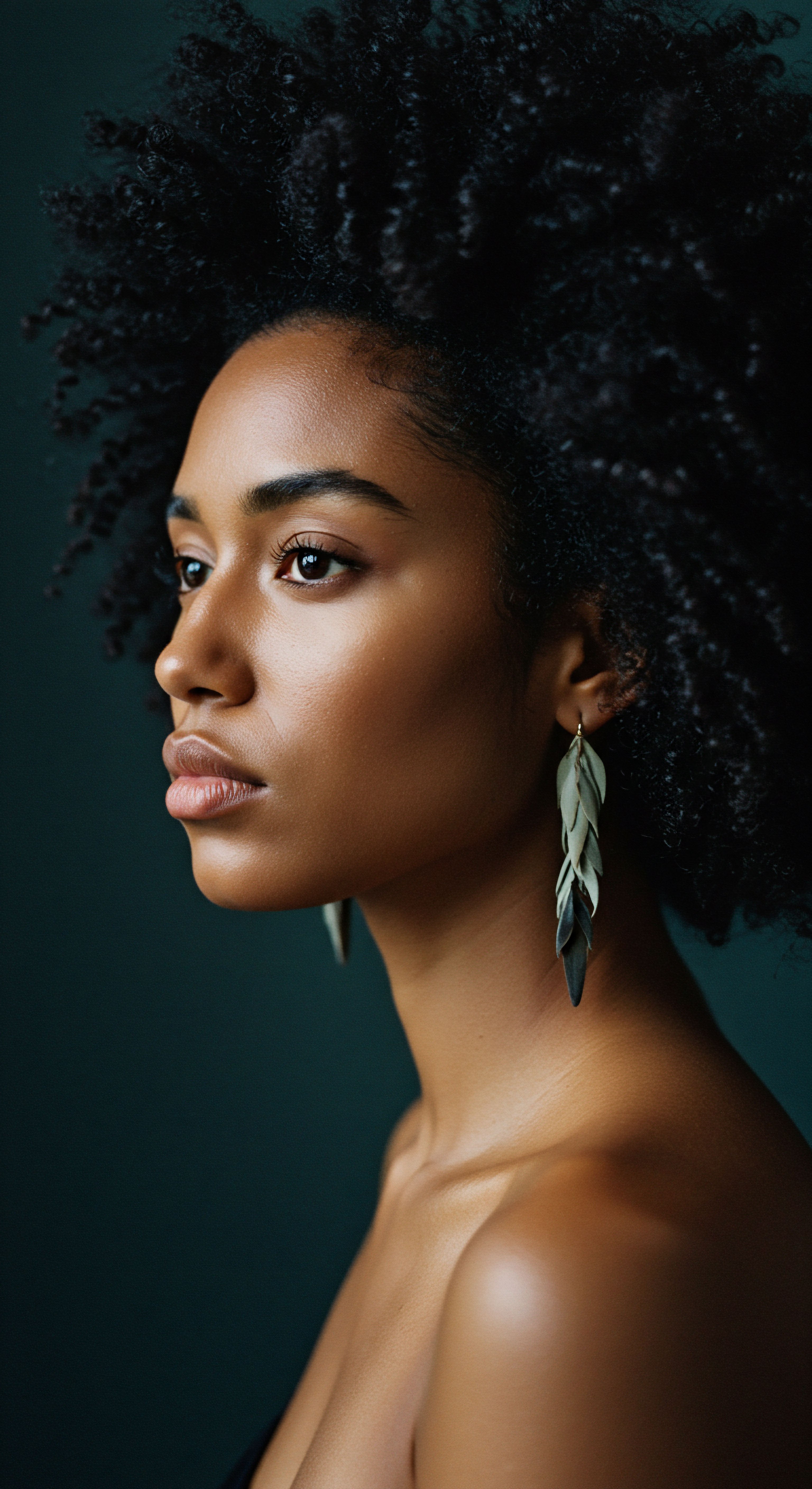
Textured Hair Classification Systems
Understanding the vast spectrum of textured hair often begins with a classification system, a way to categorize the diverse curl patterns that exist. While no single system perfectly captures the infinite variations, the most widely recognized approach typically assigns numbers and letters to describe the hair’s curl type.
- Type 1 Hair ❉ Generally straight hair, lacking a natural curl pattern.
- Type 2 Hair ❉ Wavy hair, with a gentle S-shape, ranging from loose waves (2a) to more defined waves (2c).
- Type 3 Hair ❉ Curly hair, characterized by distinct loops and spirals, from loose curls (3a) to tighter, springier curls (3c).
- Type 4 Hair ❉ Coily hair, displaying very tight, small coils, zig-zags, or kinks, with patterns ranging from tightly packed S-shapes (4a) to Z-shapes (4b) and even tighter, less defined patterns (4c).
This classification helps individuals identify their hair’s general characteristics, guiding them toward suitable care practices and product choices. However, it is vital to acknowledge that many individuals possess multiple curl patterns on their heads, creating a rich tapestry of textures. This internal variation speaks to the unique beauty of each individual’s hair.

The Essential Lexicon of Textured Hair
A specific vocabulary has developed around textured hair, reflecting its distinct qualities and care requirements. Acquiring this lexicon aids in effective communication about hair health and styling.
| Term Porosity |
| Description The hair's ability to absorb and retain moisture, determined by the cuticle's condition. High porosity hair has raised cuticles, absorbing moisture quickly but losing it just as fast. Low porosity hair has tightly closed cuticles, resisting moisture but retaining it well once absorbed. |
| Term Density |
| Description The number of individual hair strands on one's head. This influences how full the hair appears and how products distribute. |
| Term Elasticity |
| Description The hair's ability to stretch and return to its original state without breaking. Healthy hair has good elasticity, indicating sufficient moisture and protein balance. |
| Term Shrinkage |
| Description The reduction in length that occurs when curly or coily hair dries, often appearing much shorter than its actual length. This is a natural characteristic of textured hair. |
| Term Coil Pattern |
| Description The specific shape of the hair strand, ranging from loose waves to tight coils and zig-zags. |
| Term Understanding these terms empowers individuals to make informed decisions about their hair's well-being. |
These terms allow for a more precise dialogue about hair’s behavior and needs, moving beyond superficial descriptions to a more scientific understanding.

Hair Growth Cycles and Influencing Factors
Hair growth occurs in cycles, a continuous process of renewal. These cycles apply to all hair types, though individual variations exist. The three main phases are:
- Anagen ❉ The active growth phase, lasting from two to seven years. The longer this phase, the longer the hair can grow.
- Catagen ❉ A transitional phase, lasting about two to three weeks, during which hair growth stops and the outer root sheath shrinks.
- Telogen ❉ The resting phase, lasting around three months, after which the old hair sheds and new hair begins to grow.
Many factors influence these cycles, including genetics, nutrition, hormonal balance, and overall health. Stress, for instance, can prematurely shift hairs from the anagen to the telogen phase, leading to increased shedding. For individuals with textured hair, certain styling practices or environmental conditions can also impact the health of the follicle and the integrity of the growing strand. A healthy scalp environment, free from excessive tension or product buildup, is paramount for optimal growth and overall hair vitality.
Understanding the foundational science of textured hair provides a guiding light for nurturing its unique characteristics.
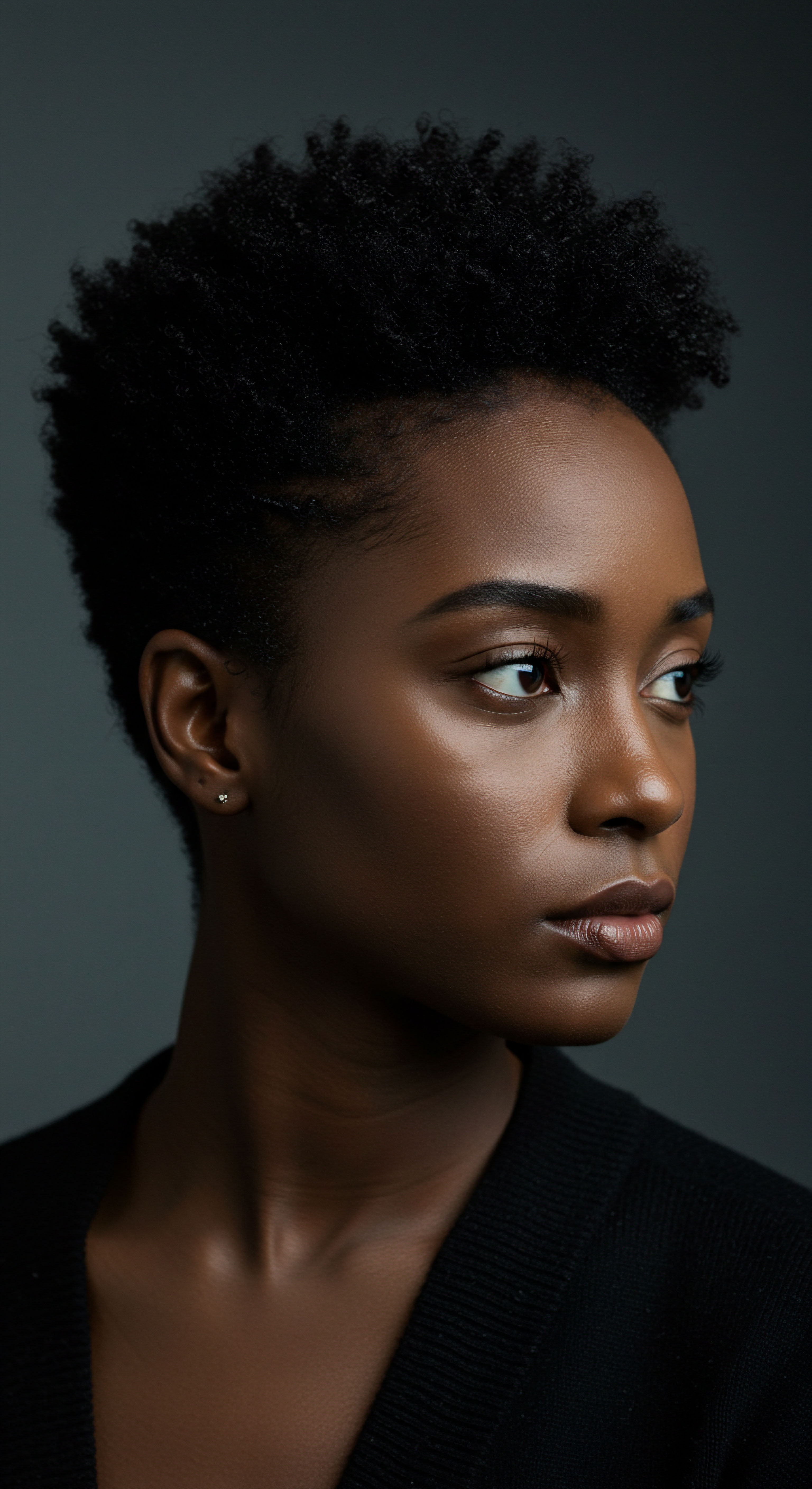
Ritual
Moving beyond the inherent structure of textured hair, we arrive at the practices, the daily and weekly rhythms that define our relationship with our strands. This is where the profound shift from a mere physical characteristic to a personal journey of well-being truly begins. It is here, in the quiet moments of application, the gentle manipulation, and the deliberate choices, that understanding transforms into tangible care.
The practices surrounding textured hair are not simply routines; they are rituals, laden with intention and capable of shaping one’s inner landscape amidst the world’s persistent gaze. This section offers guidance, a gentle hand leading through the practical wisdom that allows textured hair to flourish.
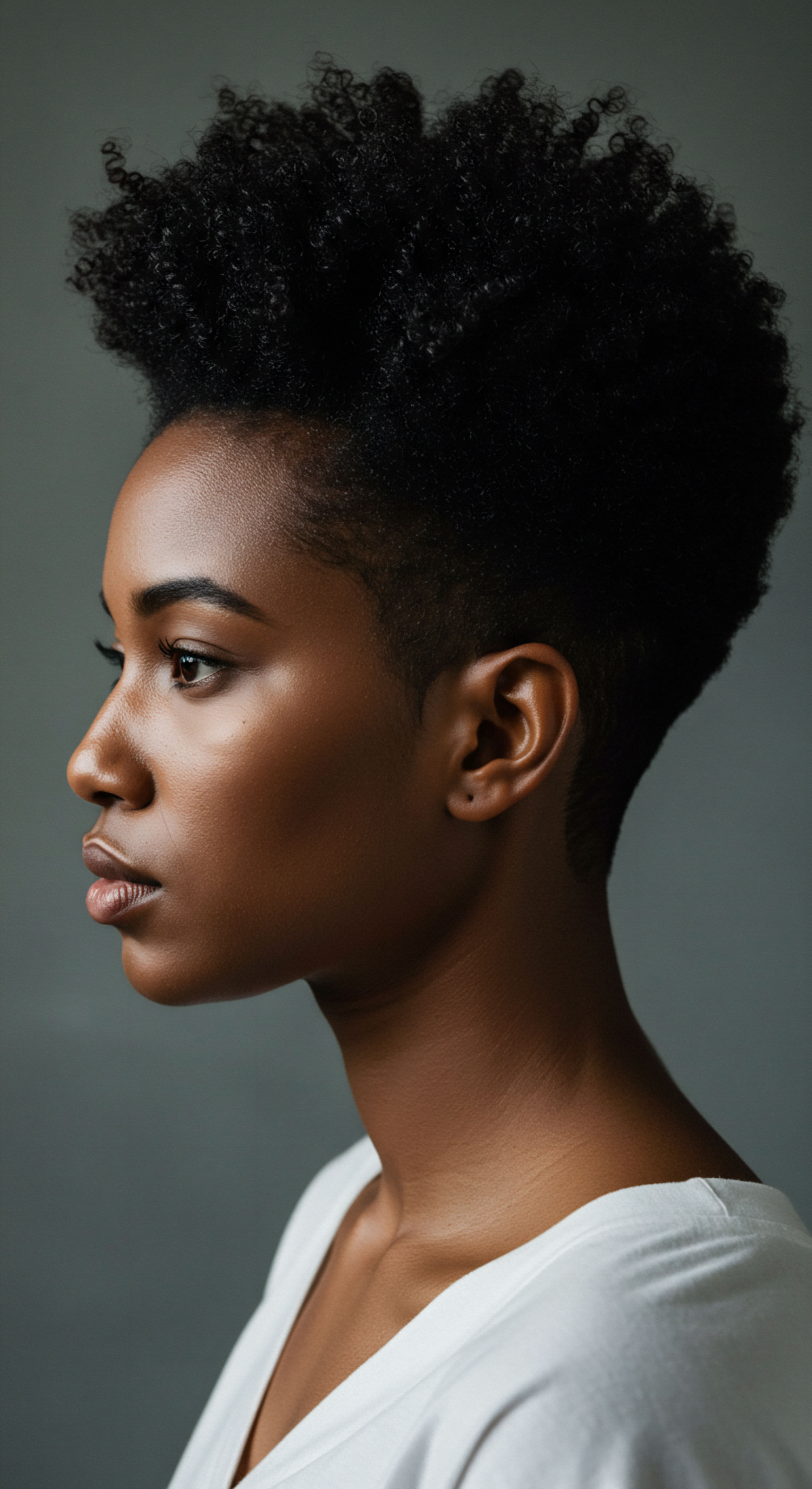
Protective Styling Encyclopedia
Protective styles serve as a shield for textured hair, minimizing manipulation and exposure to environmental elements that can lead to dryness and breakage. These styles tuck away the ends of the hair, which are the oldest and most fragile parts of the strand, allowing for length retention and overall hair health.
A wide array of options exists, each offering distinct benefits:
- Braids ❉ Classic three-strand plaits, which can be worn individually, as cornrows close to the scalp, or as box braids with extensions. They reduce daily styling needs.
- Twists ❉ Two-strand twists, flat twists, or Senegalese twists. These are often gentler on the hair than braids and can be a good option for those seeking less tension.
- Buns and Updos ❉ Simple yet effective styles that keep hair neatly secured and away from friction, preventing tangles and breakage.
- Wigs and Weaves ❉ Offer significant versatility and allow the natural hair underneath to rest completely from daily styling. Proper installation and maintenance are crucial to avoid tension and scalp irritation.
The selection of a protective style should always prioritize comfort and minimal tension on the scalp and hair edges. Overly tight styles can lead to traction alopecia, a condition that causes hair loss around the hairline. The true artistry of protective styling lies in its ability to blend aesthetic appeal with genuine hair preservation.
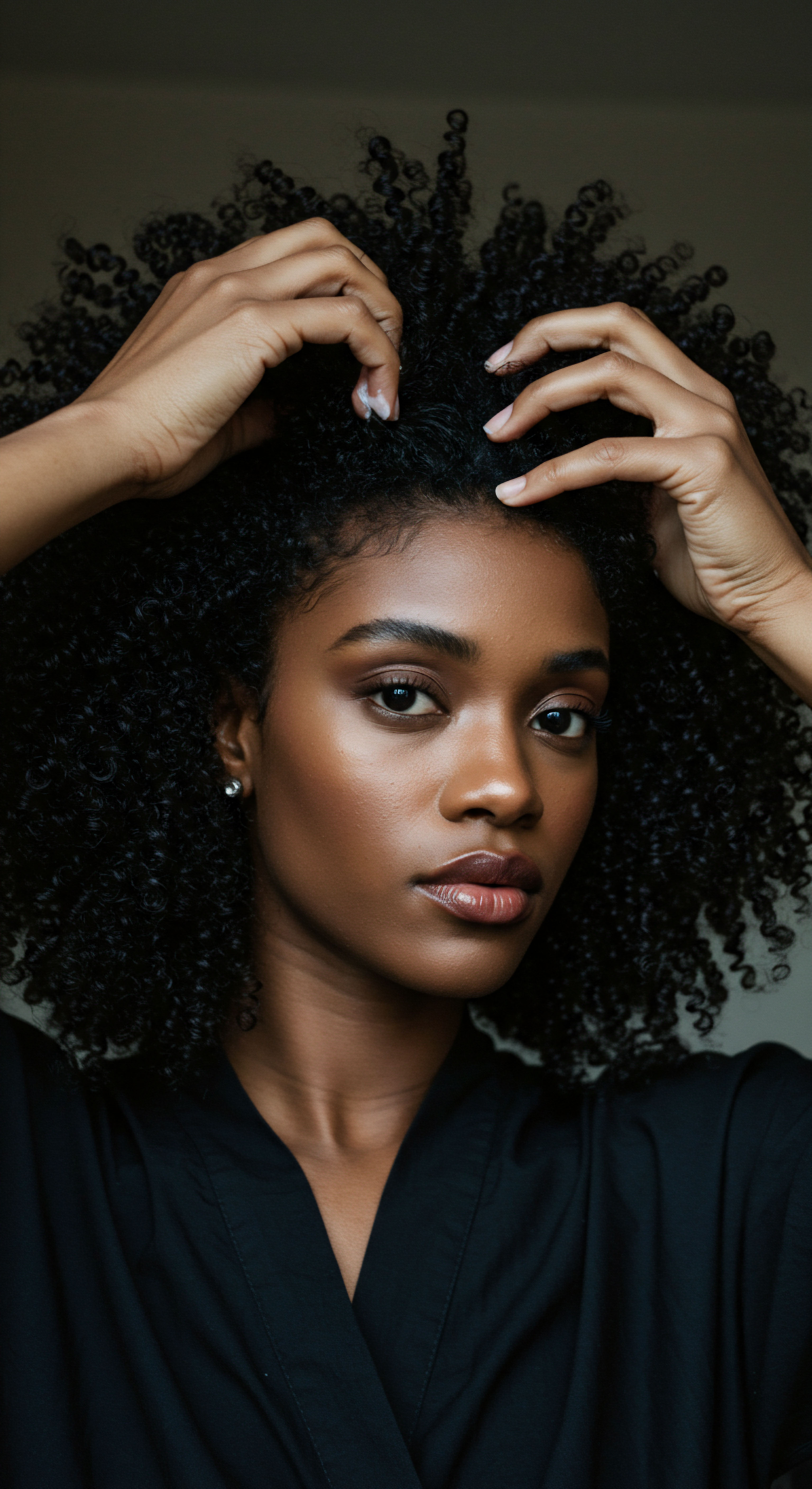
Natural Styling and Definition Techniques
Beyond protective styles, many prefer to wear their natural texture openly, celebrating its inherent form. Achieving definition and maintaining moisture are common goals.
Some widely used techniques include:
- Wash and Go ❉ This involves cleansing, conditioning, and then applying styling products to wet hair to encourage and hold the natural curl pattern as it dries. The key lies in product selection and application technique to ensure even distribution and strong curl clumps.
- Twist-Outs and Braid-Outs ❉ Hair is sectioned, moisturized, and then twisted or braided. Once dry, the twists or braids are carefully unraveled to reveal a stretched, defined wave or curl pattern. This method offers a balance of definition and reduced shrinkage.
- Finger Coiling ❉ Smaller sections of hair are coated with product and then coiled around a finger to create uniform, defined curls. This technique is time-intensive but yields highly defined results.
The success of these techniques hinges on understanding one’s unique hair porosity and density, allowing for the correct product consistency and application method. Consistent hydration before and during styling is a shared thread across all these methods.

Heat Styling and Thermal Reconditioning with Care
While the natural hair movement champions the hair’s inherent texture, some individuals still choose to straighten their hair periodically. When employing heat, a diligent, safety-first approach is paramount to preserving hair health.
Applying heat to textured hair without adequate protection can lead to permanent alteration of the curl pattern, known as heat damage. This manifests as limp, straight, or uneven sections that no longer revert to their natural state.
Consider these steps for thermal styling:
- Thermal Protectant Application ❉ Always apply a high-quality heat protectant to clean, damp hair before any heat is introduced. These products create a barrier, distributing heat more evenly and reducing direct thermal impact.
- Low Heat Settings ❉ Utilize the lowest effective heat setting on styling tools. Higher temperatures do not necessarily equate to better results and significantly increase the risk of damage.
- Minimal Passes ❉ Reduce the number of times heat is applied to the same section of hair. One or two passes with a flat iron or blow dryer should suffice if the hair is properly prepared.
- Professional Consultation ❉ For thermal reconditioning or chemical straightening, seeking a stylist experienced with textured hair is non-negotiable. These processes chemically alter the hair’s structure and require precise application to minimize damage.
Deliberate choices in styling and heat application protect hair’s vitality and natural form.

Relay
As we delve deeper into the intricate interplay between textured hair and well-being, the conversation expands beyond mere personal practices to encompass the broader societal currents that shape our experience. This is where the profound historical context, the subtle psychological impacts, and the evolving cultural narratives converge, revealing a landscape far richer and more complex than a simple matter of hair. Here, we step into a space of insightful contemplation, where scientific understanding meets cultural intelligence, allowing us to discern the multifaceted ways embracing natural hair can indeed uplift one’s personal sense of self amidst persistent external pressures.

The Societal Mirror and Hair Identity
For individuals with textured hair, particularly those of Black and mixed-race heritage, hair has never existed in a vacuum. It serves as a potent visual marker, often subject to societal interpretations and judgments that extend far beyond aesthetics. Historically, Eurocentric beauty standards have cast a long shadow, often relegating natural Black hair to categories of “unprofessional,” “unruly,” or “unacceptable” in mainstream spaces like schools and workplaces. This constant messaging, whether overt or subtle, creates an insidious pressure to conform, often leading to chemical straightening or heat styling to alter one’s inherent texture.
This external scrutiny has a tangible psychological toll. Research from TRIYBE, a mental health and hair research organization, indicates that for Black heritage communities, hair is a deeply personal and politically charged aspect of identity. Their studies and community dialogues point to significant mental health consequences arising from hair-based stigma, including Internalized Racism, Negative Self-Image, Anxiety, and Chronic Stress in academic or professional settings. The burden of feeling compelled to alter one’s hair for acceptance can be invisible, yet it is profoundly felt.
Consider the striking finding from a 2019 Dove CROWN Research Study, which revealed that Black women are 1.5 Times More Likely to Be Sent Home from Work Because of Their Hair. This statistic underscores a systemic issue where workplace bias disproportionately impacts Black women’s employment opportunities and professional advancement. The pressure to chemically straighten hair to avoid such discrimination can be both physically and psychologically damaging.

How Does Hair Bias Affect Well-Being in Professional Settings?
The subtle yet pervasive nature of hair bias in professional environments can erode an individual’s sense of belonging and competence. When professional standards are implicitly or explicitly based on characteristics of straight hair, individuals with textured hair face a choice ❉ conform and potentially compromise hair health and identity, or maintain their natural style and risk professional repercussions. A study from Michigan State University and Duke University, published in Social Psychological and Personality Science, empirically demonstrated that Black women with natural hairstyles are often perceived as less professional and less competent, and are less likely to be referred for job interviews, particularly in industries with conservative appearance norms. This bias can lead to heightened stress responses and affect self-confidence, creating a constant state of hypervigilance about how one’s hair is perceived.
The impact extends beyond the workplace. A University of Connecticut study, published in the journal Body Image, found that Black girls, more than girls of other ethnicities, reported less satisfaction with their hair and experienced hair-related discrimination and feelings of depression linked to their hair. This highlights how early experiences of hair bias can shape self-esteem from a young age, often forcing children to believe their natural appearance is “inappropriate.”

The Psychology of Hair and Self-Acceptance
The decision to wear natural hair, in the face of these external pressures, becomes a profound act of self-acceptance and defiance. It is a declaration of personal autonomy, a reclaiming of identity that has been historically marginalized. This shift can significantly improve personal well-being by fostering a deeper connection to one’s authentic self.
Clinical psychologist Dr. Afiya Mbilishaka, who created “PsychoHairapy,” describes a phenomenon she terms “hair depression,” a significant shift in mood tied to the status of one’s hair. This is particularly relevant for Black women, who often experience stress related to how their hair looks or the effort required to maintain it. Embracing natural hair, therefore, can be a therapeutic process, alleviating this specific form of psychological burden.
| Aspect of Well-Being Self-Esteem |
| Impact of Natural Hair Acceptance A direct correlation exists between self-esteem and hairstyle. Studies suggest that individuals with higher self-esteem are more likely to wear their hair in its natural state. Affirming natural texture can boost self-perception and confidence. |
| Aspect of Well-Being Identity Formation |
| Impact of Natural Hair Acceptance Natural hair serves as a powerful symbol of cultural and racial identity. Accepting one's natural hair contributes to a stronger sense of self and belonging. It can be a process of "decolonizing" both mind and body. |
| Aspect of Well-Being Reduced Stress |
| Impact of Natural Hair Acceptance Minimizing the need for chemical treatments or excessive heat styling can reduce physical damage and the associated stress of conforming to external standards. This leads to a healthier relationship with one's hair. |
| Aspect of Well-Being Community Connection |
| Impact of Natural Hair Acceptance The natural hair movement has fostered communities where individuals share experiences, advice, and support, creating a sense of solidarity and reducing feelings of isolation. |
| Aspect of Well-Being The journey to natural hair is often a journey to a more integrated and confident self. |
The psychological impact of hairstyle choices is undeniable. Transformations often coincide with life transitions, symbolizing personal growth or the assertion of a different identity. For many, a new natural look represents a symbolic rebirth, marking a conscious decision to align outward appearance with inner authenticity.

Cultural Significance and the Natural Hair Movement
The natural hair movement, particularly its resurgence in the 2000s, represents a powerful cultural shift. Building on the “Black Is Beautiful” movement of the 1960s Civil Rights era, which politicized natural hair as a form of self-acceptance and protest, the contemporary movement encourages individuals to reject chemical relaxers and embrace their inherent textures.
This movement has transcended a mere beauty trend; it is a declaration of cultural pride and resistance against historical oppression. It challenges the notion that straight hair is the epitome of beauty, asserting that Black hair, in all its diverse textures, holds inherent beauty and worth. This is not simply about personal preference; it is about reclaiming a part of cultural heritage that was systematically devalued.
One powerful illustration of this ongoing struggle and the subsequent cultural response is the development and passage of the CROWN Act (Creating a Respectful and Open World for Natural Hair). This legislation, initiated in 2019 by Dove and the CROWN Coalition, aims to prohibit race-based hair discrimination in workplaces and public schools. The very existence of such an act highlights the persistent nature of hair discrimination and the systemic barriers individuals with textured hair have faced. As of 2023, over 44% of Black women employed in the United States live in states that have yet to pass the CROWN Act, leaving them vulnerable to hair-based discrimination.
This statistic, sourced from the Economic Policy Institute, underscores the ongoing societal need for legal protections to affirm the right to wear natural hair without fear of professional or academic penalty. It is a clear indication that despite progress, the external pressures remain significant, and the act of embracing natural hair is still, for many, a courageous step towards well-being and self-determination.

Can Legal Protections Truly Alter Societal Perceptions of Hair?
While legislation like the CROWN Act provides a vital legal framework against discrimination, the deeper question remains whether laws alone can reshape deeply ingrained societal perceptions. Laws can certainly deter overt acts of discrimination and provide recourse for those affected. They can also signal a shift in acceptable public behavior and gradually influence cultural norms over time. However, changing subconscious biases and the “unwritten rules” that dictate professional appearance requires a broader cultural transformation.
The movement’s influence extends beyond legal frameworks. Social media platforms have played a significant role in fostering virtual communities where individuals share their personal hair experiences, offer advice, and showcase a vast array of natural hairstyles. This digital solidarity helps to counter negative societal messages and reinforce positive self-perception. These platforms serve as spaces for collective healing and affirmation, allowing individuals to connect over shared journeys and celebrate their unique beauty.
Ultimately, embracing natural hair is a deeply personal choice with profound societal implications. It is a powerful act of self-love and cultural affirmation that, while sometimes met with external resistance, undeniably contributes to a stronger sense of self, reduced psychological burden, and a more authentic expression of identity. The path to well-being, for many, begins with the acceptance of the crown they naturally wear.
The embrace of natural hair is a declaration of personal freedom, a deep wellspring for well-being.

Reflection
The journey of textured hair, from its very roots to its outward expression in a world often resistant to its inherent form, stands as a testament to the enduring human spirit. It is a quiet revolution unfolding on countless heads, a reclaiming of self in the face of inherited expectations. The decision to let one’s hair exist in its authentic state is more than a styling choice; it is a dialogue with history, a conversation with culture, and a profound affirmation of individual worth. As we move forward, the gentle whisper of acceptance for natural hair grows louder, a collective voice celebrating the unique beauty that has always been present, waiting to be seen, appreciated, and cherished.
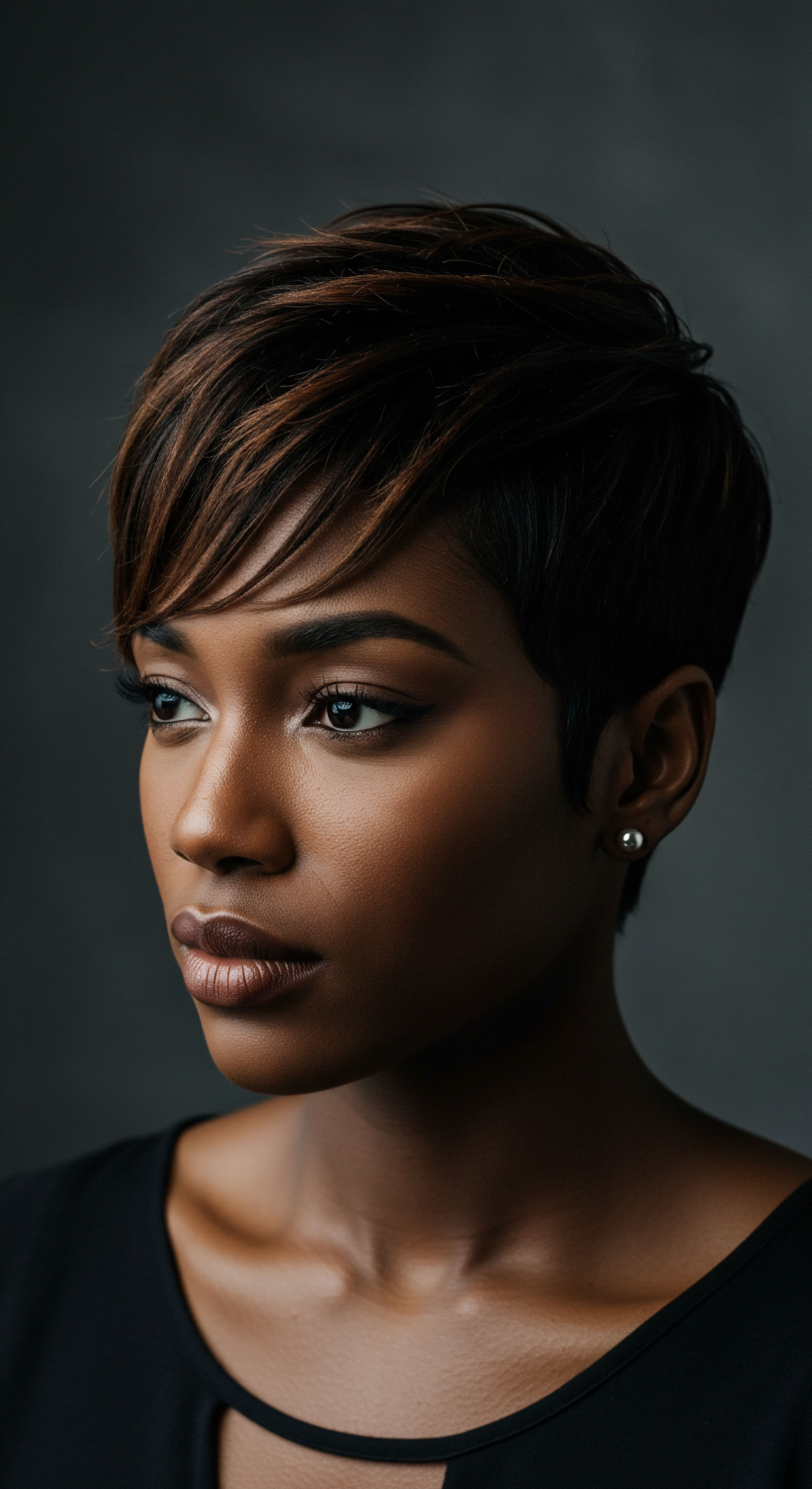
References
- Maharaj, C. (2025, May 15). Beyond the roots ❉ exploring the link between black hair and mental health. TRIYBE.
- Jenkins, N. D. (2019, July 3). How Natural Black Hair at Work Became a Civil Rights Issue. JSTOR Daily.
- Byrd, A. D. & Tharps, L. L. (2014). Hair Story ❉ Untangling the Roots of Black Hair in America. St. Martin’s Press.
- Johnson, T. B. & Bankhead, T. (2014). The Social Psychology of Hair ❉ A Look at Race and Identity. In D. J. Thompson (Ed.), The Psychology of Hair. Nova Science Publishers.
- Byrd, A. D. & Tharps, L. L. (2001). Hair Story ❉ Untangling the Roots of Black Hair in America. St. Martin’s Press.
- She Reads. (2022, November 18). 10 Books On the Evolution of Black Culture Through Hair.
- Martom. (2025, March 24). The Psychology of Hair ❉ How Your Hairstyle Reflects Your Identity.
- Hair People Denver. (2025, March 24). The Psychology of Hair ❉ How Your Hairstyle Influences Your Mood.
- Johnson, T. (2022, October 31). “Don’t Touch My Crown” ❉ The Future of the Natural Hair Movement.
- Donaldson, S. (2022, November 10). How the Early Natural Hair Movement Changed the Beauty World as We Know It. Byrdie.
- Lisse, A. A. (2025, February 5). Hair Love | How Black Girls’ Hair Influences Mental Health.
- Unity. (n.d.). How Your Hair Affects Your Confidence and Self-Esteem (Psychology of Hair).
- Johnson, D. (2021, May 26). How the CROWN Act Impacts You. NaturallyCurly.com.
- UNITY. (2023, July 24). Hair talks about you ❉ discover the importance of its care for your self-esteem.
- Lordhair.com. (2023, October 30). The Natural Hair Revolution ❉ A Market Trend Analysis.
- Holistic Hair Studio. (2025, March 6). The Role of Hair in Self-Expression and Confidence.
- Dabiri, E. (2020). Twisted ❉ The Tangled History of Black Hair Culture. Harper Perennial.
- The Kurl Kitchen. (2025, January 7). The Natural Hair Revolution ❉ A Market Trend Analysis.
- Prose. (2021, June 25). How PsychoHairapy Can Help You Fully Accept Your Hair.
- Columbia College. (n.d.). Hair story ❉ untangling the roots of Black hair in America.
- Mahogany Books. (2014, January 28). Hair Story ❉ Untangling The Roots Of Black Hair In America (PB) (2014).
- Rodriguez, S. (2023). Black Hair Can ❉ The Roots of Our Roots. Barnes & Noble.
- Nkimbeng, M. Rumala, B. B. M. Richardson, C. M. Stewart-Isaacs, S. E. & Taylor, J. L. (2023, August 2). The Person Beneath the Hair ❉ Hair Discrimination, Health, and Well-Being. Health Equity, 7(1), 543–550.
- Arizona State University. (2022, May 24). Study ❉ Black girls commonly have negative experiences related to their natural hair.
- Black & Bookish. (2017, August 11). “Hair Story” Provides History and Perspective to Why It’s More Than Just Hair (Book Review).
- Smart, M. (2014, February 10). Hair Story ❉ Untangling The Roots Of Black Hair In America.
- Blackshear, T. B. & Kilmon, K. (2020, November 17). Natural Hair ❉ a Vital Component to Black Women’s Health. J Racial Ethn Health Disparities, 8(6), 1573-1582.
- Bounce Black. (n.d.). Hair and Mental Health.
- Hamilton, G. (2022). Black Women, Hair, and Self-Esteem. eScholarship.org.
- The Official CROWN Act. (n.d.).
- Michigan State University. (2020, September 18). MSU research exposes discrimination against Black women with natural hair.
- Adekunle, A. (2019, May 25). What do I do with my hair? Identity, performance and social representations of Black hair in women of colour in England and Germany. Apollo.
- EliScholar. (2023, May 12). The Development Of A Self- Esteem Toolkit For Black Adolescent Girls Centering Hair As A.
- Joseph, T. (2009). The Hair Issue ❉ Political Attitude and Self-Esteem as Determinants of Hairstyle Choices Among African American Women. Cal State Open Journals.
- Downey Brand. (2024, May 1). Strands of Change ❉ How the CROWN Act Shapes Our Understanding of Professionalism.
- Harvard Gazette. (2025, January 2). Natural Black hair, and why it matters.
- Dancey, T. E. Edwards, K. T. & Davis, J. E. (2023, October 9). Black Hair and Hair Texture ❉ Cultivating Diversity and Inclusion for Black Women in Higher Education. Emerald Insight.
- The Official CROWN Act. (n.d.). The 2019 CROWN Research Study for Women.
- Economic Policy Institute. (2023, July 26). The CROWN Act ❉ A jewel for combating racial discrimination in the workplace and classroom.
- The Wooster Voice. (2024, October 25). Hair Down ❉ a discussion on black hair and mental health.
- Duke’s Fuqua School of Business. (2020, August 12). Ashleigh Rosette | Research Suggests Bias Against Natural Hair Limits Job Opportunities for Black Women.
- Nkimbeng, M. Rumala, B. B. M. Richardson, C. M. Stewart-Isaacs, S. E. & Taylor, J. L. (2025, February 8). The Person Beneath the Hair ❉ Hair Discrimination, Health, and Well-Being. ResearchGate.